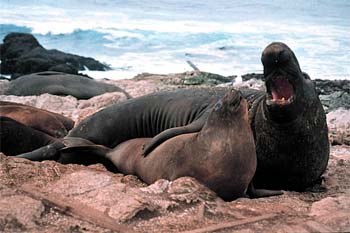Elephant seals or sea elephants are very large, oceangoing earless seals in the genus Mirounga. Both species, the northern elephant seal (M. angustirostris) and the southern elephant seal (M. leonina), were hunted to the brink of extinction for oil by the end of the 19th century, but their numbers have since recovered. They can weigh up to 4,000 kilograms (8,800 lb). Despite their name, elephant seals are not closely related to elephants, and the large proboscis or trunk that males have was convergently evolved.
The northern elephant seal, somewhat smaller than its southern relative, ranges over the Pacific coast of the U.S., Canada and Mexico. The most northerly breeding location on the Pacific Coast is at Race Rocks Marine Protected Area, at the southern tip of Vancouver Island in the Strait of Juan de Fuca. The southern elephant seal is found in the Southern Hemisphere on islands such as South Georgia and Macquarie Island, and on the coasts of New Zealand, Tasmania, South Africa, and Argentina in the Peninsula Valdés. In southern Chile, there is a small colony of 120 animals at Jackson Bay (Bahía Jackson) in Admiralty Sound (Seno Almirantazgo) on the southern coast of Isla Grande de Tierra del Fuego.
The oldest known unambiguous elephant seal fossils are fragmentary fossils of a member of the tribe Miroungini described from the late Pliocene Petane Formation of New Zealand. Teeth originally identified as representing an unnamed species of Mirounga have been found in South Africa, and dated to the Miocene epoch; however, Boessenecker and Churchill (2016) considered these teeth almost certainly to be misidentified toothed whale (odontocete) teeth. The elephant seals evolved in the Pacific Ocean during the Pliocene period.
Elephant seals breed annually and are seemingly habitual to colonies that have established breeding areas.
